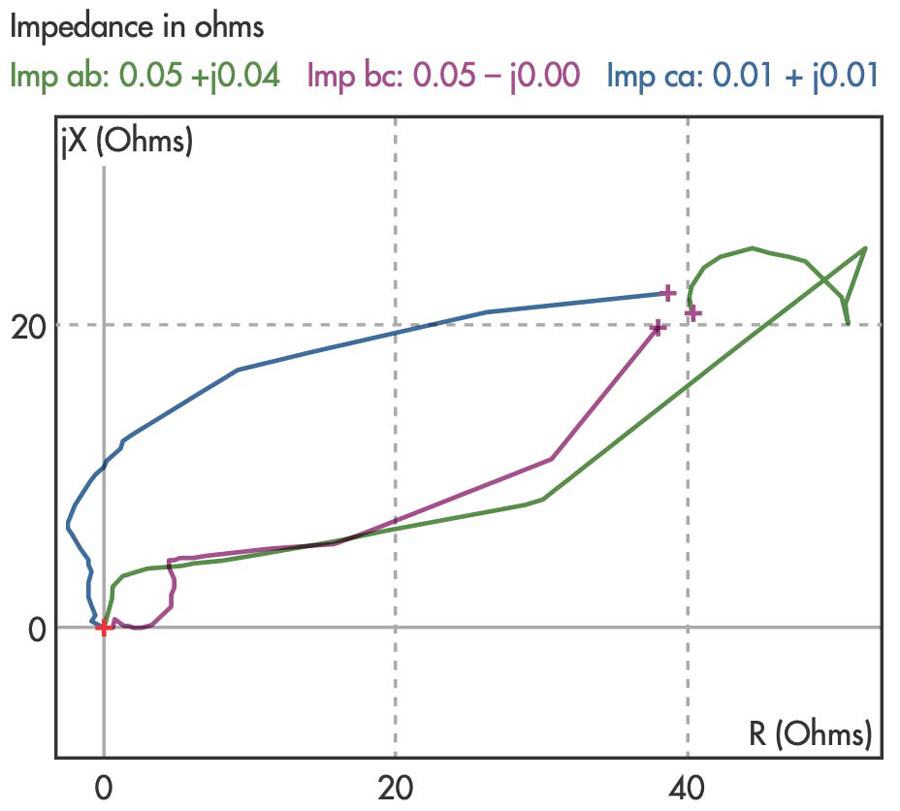This article analyzes several protection operations for large combustion turbine generators. Generator protection trips tend to be rare, so any major event is always of interest.
EVENT 1: CLOSE-IN THREE-PHASE FAULT
A large gas combustion turbine generator experienced a close-in three-phase fault during a rainstorm. The generator terminal voltage is rated 13.8 kV line-to-line, and the machine is high-impedance grounded. The phase VTs are connected open delta. Figure 1 is the corresponding oscillography captured by the generator protection relay.

Figure 1: Oscillography for Event 1
The fault was located close to the phase VTs and just external to the generator differential zone of protection. The fault was properly cleared by the 50 high-set phase instantaneous protection, which operated just under two cycles following fault inception. The generator breaker tripped open four cycles later. The pre-fault load current was 50% of the rated full load.
Figure 2 shows the fault impedance ZAB, ZBC, and ZCA measured by the generator protection relay. The pre-fault load impedance drops close to zero ohms following fault inception.

Figure 2: Fault Impedance Measured by Generator Protection Relay
Figure 3 shows the machine rotor, which was pulled for inspection due to the fault.

Figure 3: Rotor
EVENT 2: ROTOR GROUND FAULT
The second event is a rotor ground fault that occurred for another large combustion turbine generator — also during a rainstorm. Figure 4 shows the rotor field resistance to ground measured by the generator protection relay over a period of one month leading up to the event.

Figure 4: Rotor Field Resistance to Ground
The orange plot is of interest and represents the measured rotor field insulation resistance to ground. The ground fault occurred between 07-28-2021 and 08-02-2021. Review of the plot shows that the field resistance dropped to zero, then slowly began to increase back to the pre-fault nominal value over the course of several days. The ground was due to water ingress that evaporated over time after the rainstorm. The spike was due to testing following the event. The relay reports a large value when the measuring module is removed from service.
CONCLUSION
Two very different causes of large generator protection trip events were analyzed. They demonstrate the proper setting and operation of modern protection devices as well as the data-capture capability that allows for accurate understanding of the respective initiating insulation failures.
 Steve Turner is in charge of system protection for the Fossil Generation Department at Arizona Public Service Company in Phoenix. Steve worked as a consultant for two years, and held positions at Beckwith Electric Company, GEC Alstom, SEL, and Duke Energy, where he developed the first patent for double-ended fault location on overhead high-voltage transmission lines and was in charge of maintenance standards in the transmission department for protective relaying. Steve has BSEE and MSEE degrees from Virginia Tech University. Steve is an IEEE Senior Member and a member of the IEEE PSRC, and has presented at numerous conferences.
Steve Turner is in charge of system protection for the Fossil Generation Department at Arizona Public Service Company in Phoenix. Steve worked as a consultant for two years, and held positions at Beckwith Electric Company, GEC Alstom, SEL, and Duke Energy, where he developed the first patent for double-ended fault location on overhead high-voltage transmission lines and was in charge of maintenance standards in the transmission department for protective relaying. Steve has BSEE and MSEE degrees from Virginia Tech University. Steve is an IEEE Senior Member and a member of the IEEE PSRC, and has presented at numerous conferences.
